

Shradha A.H. Ahuja is a transformation executive who solves complex problems at the intersection of people, systems, and business strategy. With over two decades of experience across banking, professional services, and marine offshore, she brings clarity to chaos in environments where strategy, execution, and human dynamics often collide.
Her work has delivered award-winning impact, from workforce transformations recognized by ATD and Brandon Hall, to large-scale operational shifts under high-pressure conditions. In 2024, she was named a Global Power Leader in HR by White Page International.
Currently serving as Chief Shared Services Officer at a UAE-based marine company, Shradha leads HR, IT, and Procurement with a sharp focus on alignment and execution. She recently stepped into public thought leadership via the Streamly Change Management Series, where she shares grounded insights drawn from real-world transformation work.
Her leadership philosophy? No templates. No theatrics. Just strategic alignment that works - especially when change is urgent, messy, or overdue.
Available For: Advising, Authoring, Consulting, Speaking
Travels From: Abu Dhabi
Speaking Topics: 1. Leading Change When It’s Messy 2. Strategic Presence for Quiet Performers 3. People × Systems × Strategy: The Real Reason Change Fails
| Shradha A.H. Ahuja | Points |
|---|---|
| Academic | 0 |
| Author | 43 |
| Influencer | 18 |
| Speaker | 9 |
| Entrepreneur | 0 |
| Total | 70 |
Points based upon Thinkers360 patent-pending algorithm.
 The Cost of Silence: How Good Teams Lose Their Voice
The Cost of Silence: How Good Teams Lose Their Voice
Tags: Change Management, Leadership, Transformation
 The Reward Rift: What We Say We Value vs. What We Actually Reward
The Reward Rift: What We Say We Value vs. What We Actually Reward
Tags: Change Management, Leadership, Transformation
 Quiet Quitting Is a Mirror, Not a Mystery
Quiet Quitting Is a Mirror, Not a Mystery
Tags: Change Management, Leadership, Transformation
 “They’re Not Ready” — Or Is It You Who’s Not Ready to Let Go?
“They’re Not Ready” — Or Is It You Who’s Not Ready to Let Go?
Tags: Change Management, Leadership, Transformation
 When Praise Feels Like Politics
When Praise Feels Like Politics
Tags: Change Management, Leadership, Transformation
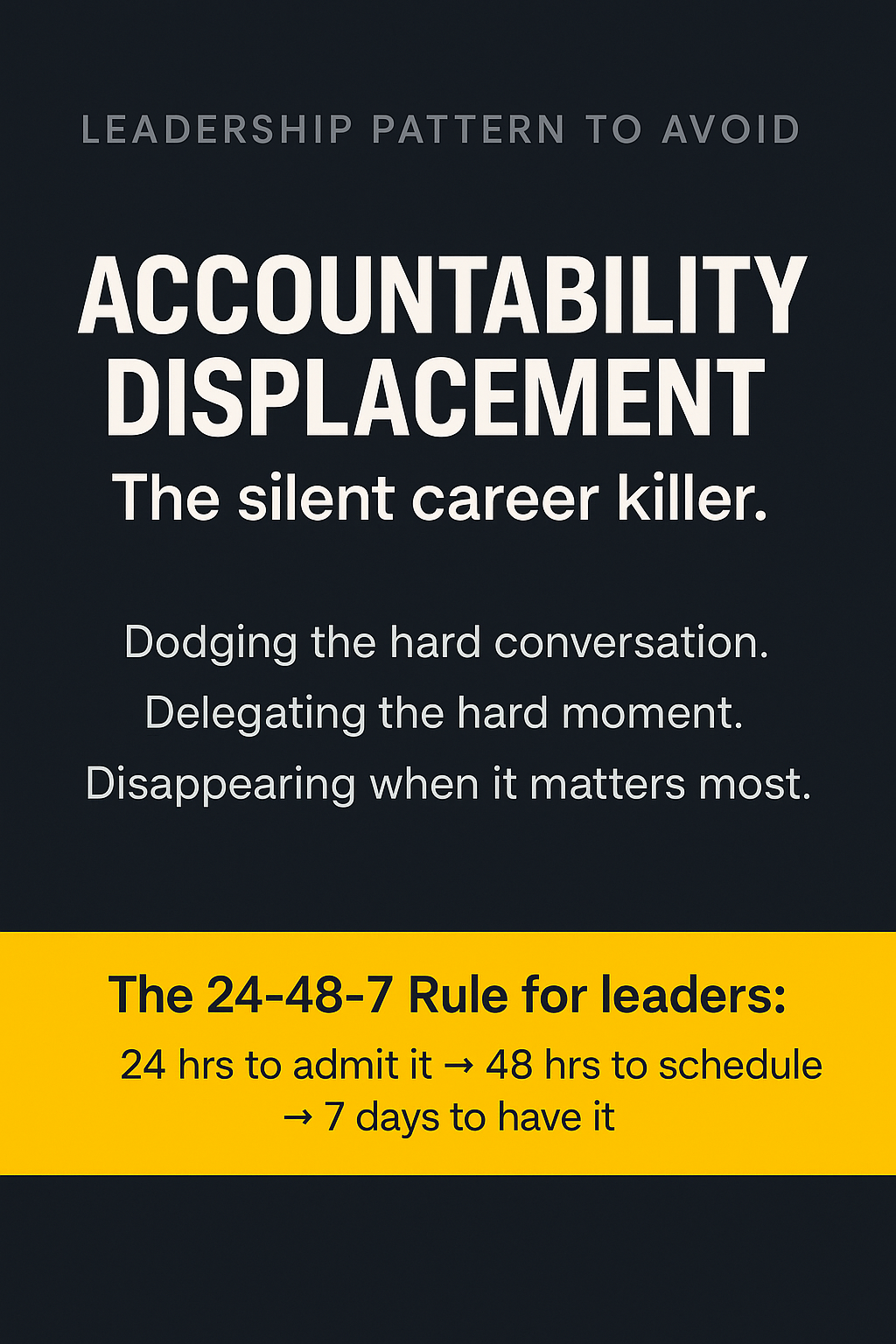 Accountability Displacement: When Leaders Outsource the Hardest Part of Their Job
Accountability Displacement: When Leaders Outsource the Hardest Part of Their Job
Tags: Change Management, Leadership, Transformation
 When Staying Late Became a Measure of Loyalty
When Staying Late Became a Measure of Loyalty
Tags: Change Management, Leadership, Transformation
 It Wasn’t About the Parking Lot
It Wasn’t About the Parking Lot
Tags: Change Management, Leadership, Transformation
 When Leadership Becomes the Bottleneck
When Leadership Becomes the Bottleneck
Tags: Change Management, Leadership, Transformation
 The Process Isn’t Broken. But Is It Helping?
The Process Isn’t Broken. But Is It Helping?
Tags: Change Management, Leadership, Transformation
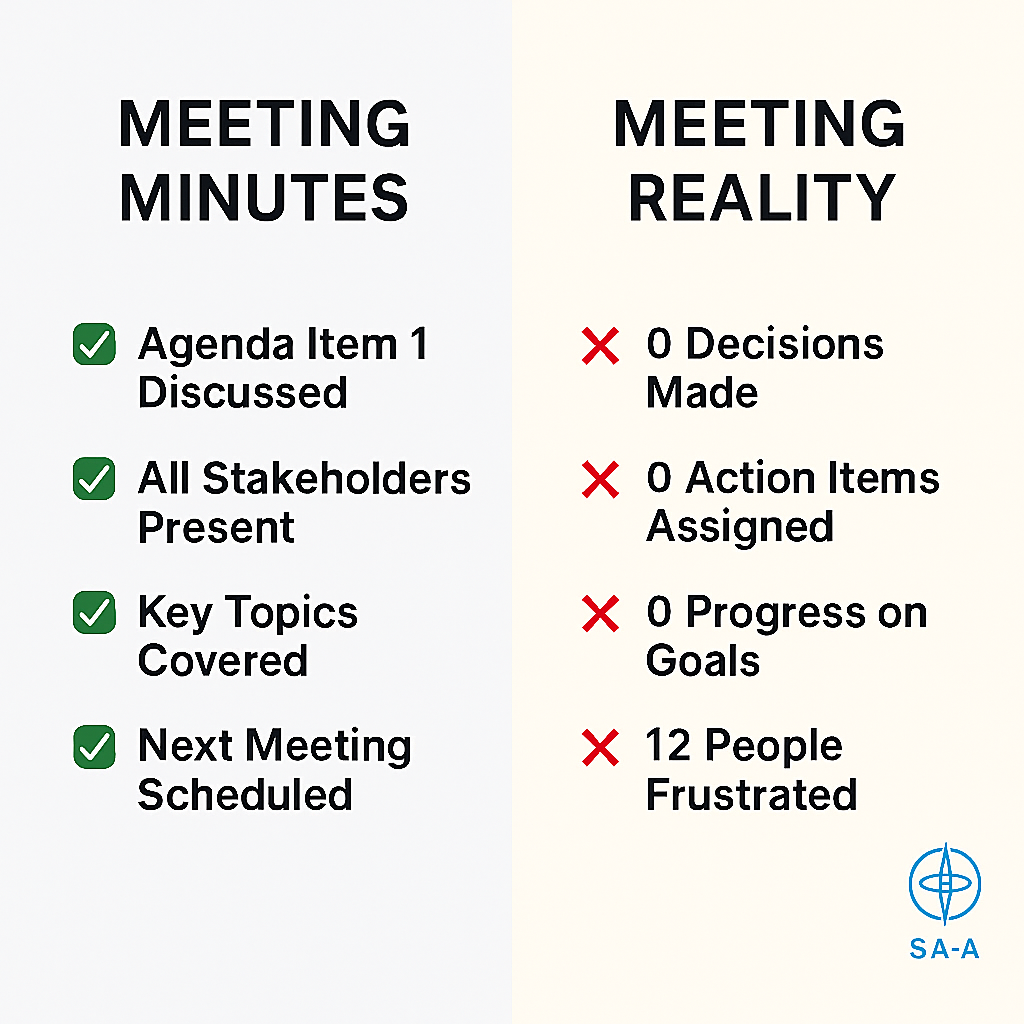 The Meeting Didn’t Fail Because the Agenda Was Wrong.
The Meeting Didn’t Fail Because the Agenda Was Wrong.
Tags: Change Management, Leadership, Transformation
 Your Team Didn’t Stop Caring. They Stopped Believing.
Your Team Didn’t Stop Caring. They Stopped Believing.
Tags: Change Management, Leadership, Transformation
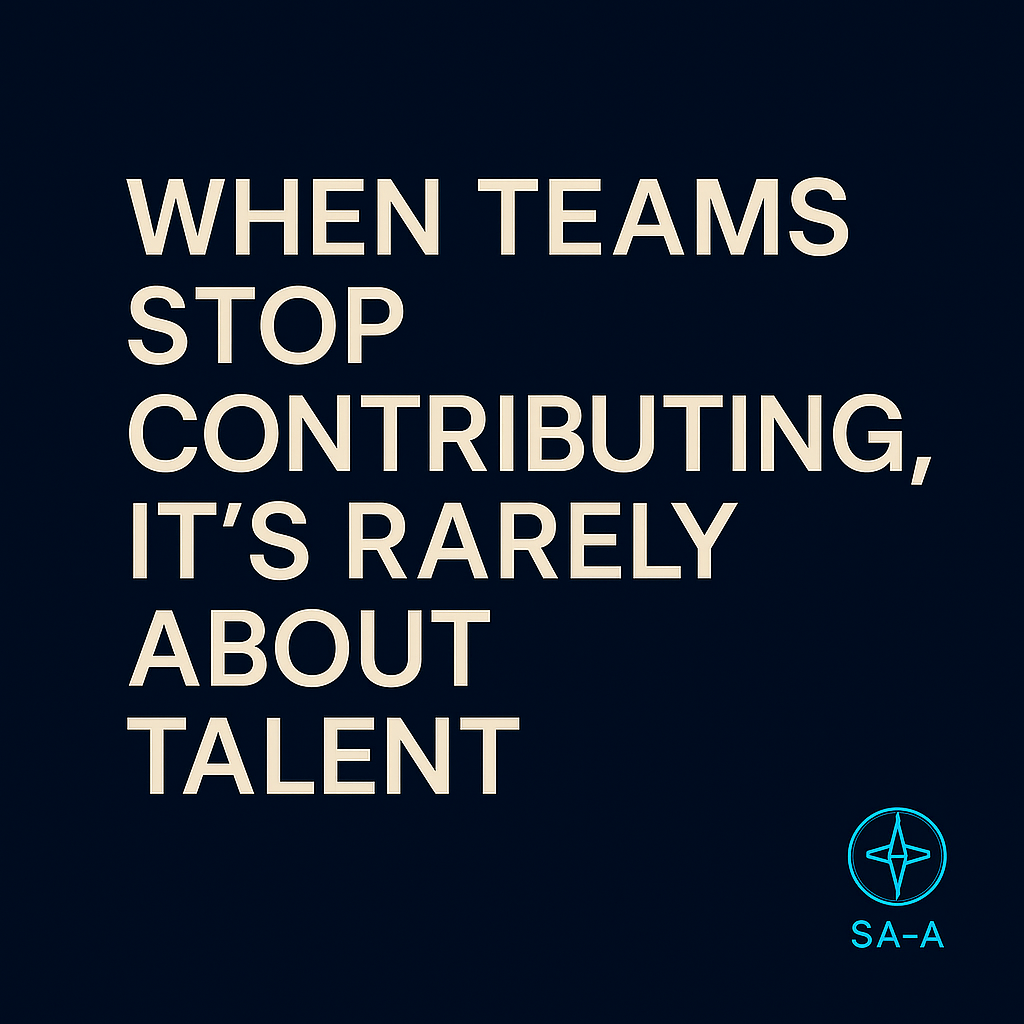 When Teams Stop Contributing, It’s Rarely About Talent
When Teams Stop Contributing, It’s Rarely About Talent
Tags: Change Management, Leadership, Transformation
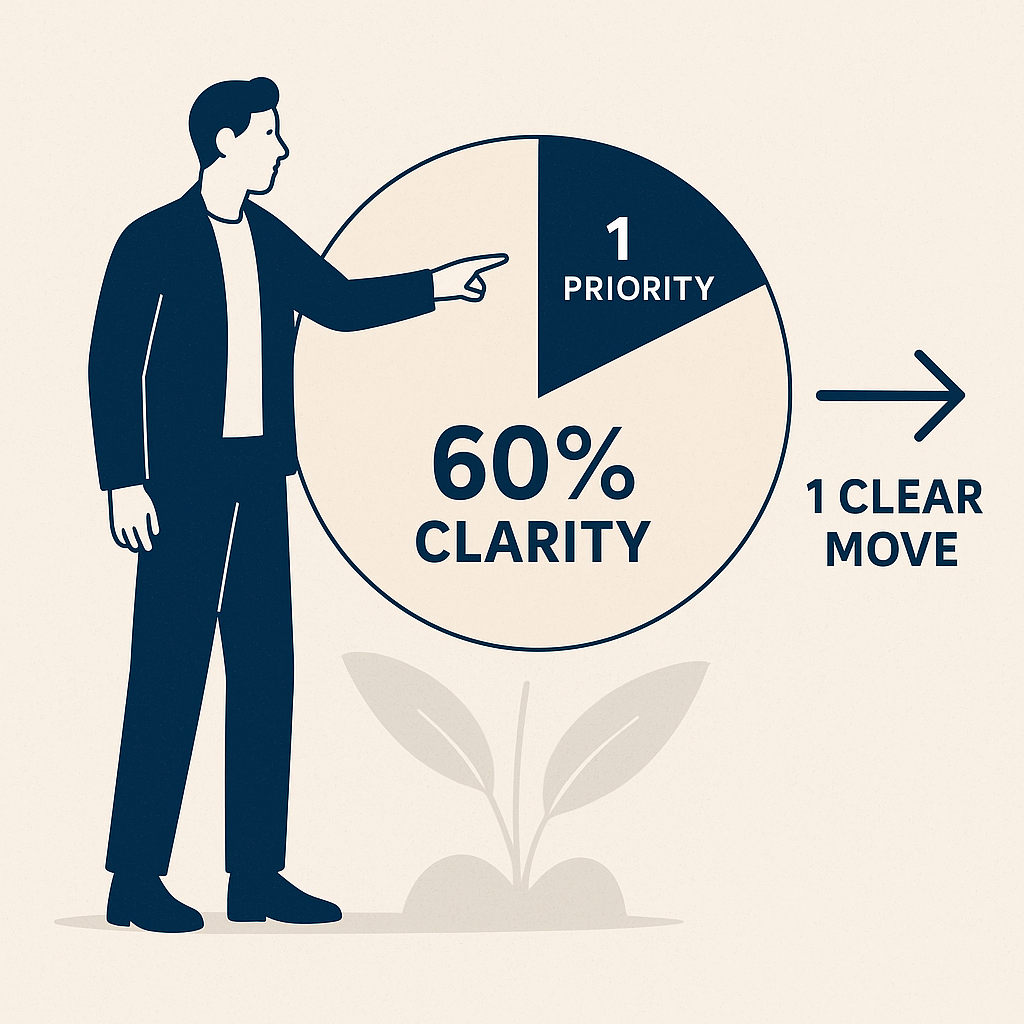 Decisiveness Isn’t a Leadership Trait. It’s a Survival Strategy.
Decisiveness Isn’t a Leadership Trait. It’s a Survival Strategy.
Tags: Change Management, Leadership, Transformation
 When You Stop Seeing What’s No Longer Working
When You Stop Seeing What’s No Longer Working
Tags: Change Management, Leadership, Transformation
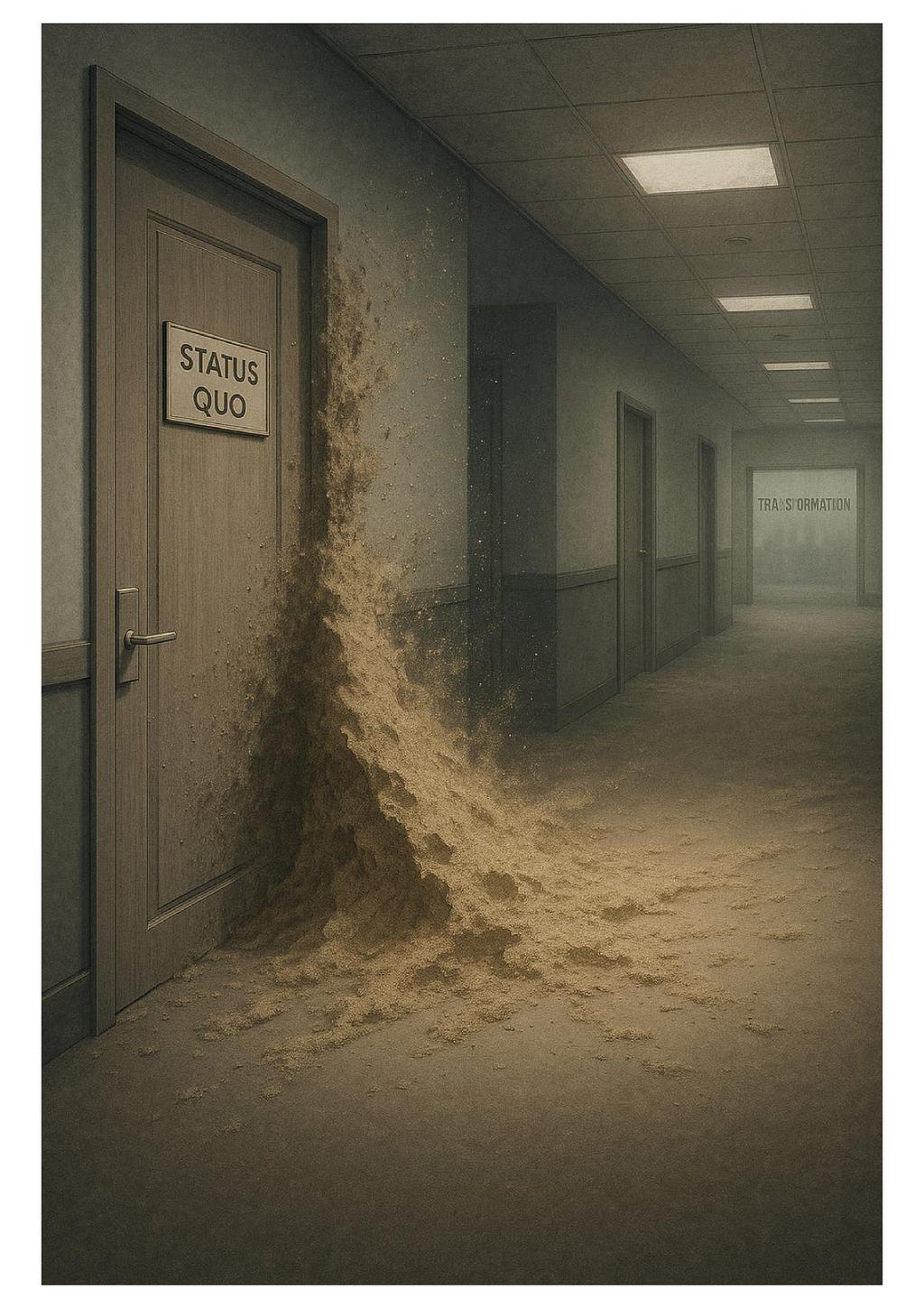 Comfort Isn’t a Strategy. It’s a Slow Death.
Comfort Isn’t a Strategy. It’s a Slow Death.
Tags: Change Management, Leadership, Transformation
 Women Super Achiever Award
Women Super Achiever Award
Tags: Transformation
 Chosen among Global 200 Power Leaders in HR 2024
Chosen among Global 200 Power Leaders in HR 2024
Tags: Agile, HR, Leadership
 Transforming Shared Services in the GCC - Touchless Digital Operations
Transforming Shared Services in the GCC - Touchless Digital Operations
Tags: Change Management, Leadership, Transformation
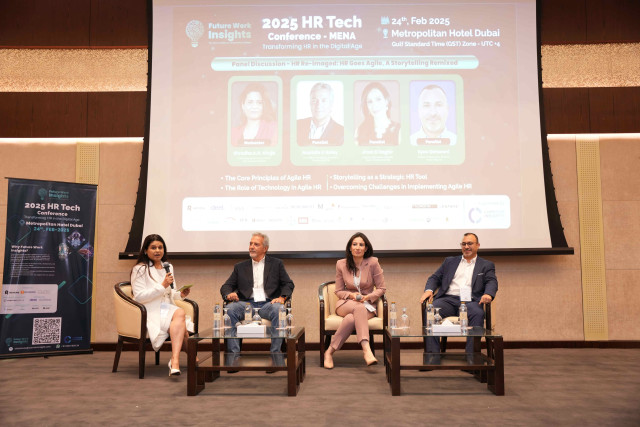 Agile HR
Agile HR
Tags: Agile, HR, AGI
 Personalised HR - The secret to Employee Engagement & Retention
Personalised HR - The secret to Employee Engagement & Retention
Tags: Future of Work, HR, Leadership
 The Science of Engagement: Cracking the Code for High PerformancePaid
The Science of Engagement: Cracking the Code for High PerformancePaid
Tags: Change Management, Leadership, Transformation
 How to engage employees in change management and reduce resistance
How to engage employees in change management and reduce resistance
Tags: Agile, HR, Change Management
Tags: Change Management, Future of Work, Transformation
 Who Gets the Room: Why Access Is the Most Misunderstood Signal in Organizations
Who Gets the Room: Why Access Is the Most Misunderstood Signal in Organizations
Access has always been a quiet marker of influence.
Not the formal kind listed on organization charts, but the lived kind, visible in who gets invited, who stays excluded, and whose presence changes the tone of a room.
In the last decade, companies have invested heavily in values, leadership programs, and communication strategies. But very few have audited the most decisive cultural signal of all: who gets access to decision-making spaces.
Access isn’t about hierarchy.
It’s about trust.
It’s about who leaders believe will “add value,” “stay aligned,” or “not slow things down.”
These choices may feel harmless in isolation, but repeated over time, they quietly define what the organization truly rewards.
Every invitation teaches people something.
When the same voices are always in the room, teams learn that familiarity matters more than competence.
When people are added “to keep them informed,” they learn that status matters more than contribution.
When critical contributors are left out until the end, they learn that real decisions happen elsewhere.
Access becomes a curriculum - one that employees study very carefully.
Most leaders don’t intentionally exclude.
But many operate under assumptions shaped by speed, comfort, and habit.
“This person will say yes.”
“This person won’t challenge too much.”
“This person already knows the backstory.”
“This person is easier to work with.”
Over time, these preferences harden into structure.
A small circle forms.
Decision-making speeds up, but decision quality declines.
Not because leaders lack clarity,
but because the room lacks diversity of truth.
When access becomes predictable, organizations unintentionally reward conformity.
People stop questioning decisions because they don’t want to lose their seat.
Others disengage because they know they’ll never get one.
This is how organizations drift from transparency to convenience.
The irony is that most leaders believe their access patterns are neutral.
But access is never neutral.
It is always a signal - loud, structural, and remembered.
Organizations need better access hygiene:
Make the invite list intentional, not habitual.
Add people for expertise, not politics.
Rotate voices to prevent intellectual stagnation.
Let people decline without penalty.
Remove people who are added only for optics.
The room shouldn’t reflect hierarchy.
It should reflect relevance.
You can tell everything about a culture by who is allowed into the room.
Not by titles, but by trust.
Not by hierarchy, but by habit.
If organizations want alignment, speed, and genuine contribution, they must first fix the most overlooked system signal they send:
Access.
Tags: Leadership, Change Management, Transformation
 Decision Theaters: When Data Becomes a Disguise
Decision Theaters: When Data Becomes a Disguise
We’ve all been in those meetings.
The ones filled with slides, dashboards, and charts that seem to prove everything’s under control.
The numbers look good.
The colors are green.
And yet, nothing actually changes.
That’s the modern Decision Theater - where information performs, but insight never lands.
As organizations matured digitally, data became the language of legitimacy.
We learned to quantify, measure, and benchmark almost everything.
But somewhere along the way, data stopped being a tool for discovery and became a shield for validation.
Dashboards evolved from instruments of learning into instruments of performance - not to make better decisions, but to justify existing ones.
When every conversation is a presentation, not an exploration, the system rewards what looks credible, not what’s true.
Being data-driven is often confused with being data-aware.
In many companies, decisions still start with intuition, politics, or hierarchy, and the data simply arrives later to decorate the conclusion.
Metrics are cherry-picked. Trends are smoothed. Outliers are dismissed as anomalies rather than signals.
And slowly, the organization builds muscle memory around confirmation, not curiosity.
It feels safe. It looks rigorous.
But it’s theater - a performance designed to project competence rather than uncover reality.
Decision Theater isn’t born from incompetence. It’s a byproduct of fear and fatigue.
When failure is punished, when time is scarce, and when leaders are overloaded with noise, the temptation to simplify reality is strong.
Dashboards offer clarity, even if it’s cosmetic.
They turn uncertainty into numbers and doubt into slides.
And once those slides are approved, no one wants to reopen the script.
But this comfort comes at a cost: curiosity dies, dissent fades, and blind spots deepen.
Theater-driven decisions create organizations that look efficient but move in circles.
Projects stay “on track” long after they’ve lost relevance.
Teams keep reporting success on metrics that no longer matter.
And innovation becomes a story, not a system.
The tragedy isn’t that people lie with data.
It’s that they stop questioning it.
When that happens, data ceases to be a mirror and becomes a mask.
Escaping the Decision Theater isn’t about removing dashboards or analytics.
It’s about reintroducing truth-seeking as a habit.
Separate insight from image. Make it safe to challenge data sources and underlying assumptions.
Reward discovery, not defense. Recognize people who reveal problems early, not those who hide them well.
Shift from reports to reflection. Replace one-way presentations with discussions that probe “what we don’t yet know.”
The real power of data lies in discomfort - in exposing patterns we’d rather not see.
Every organization needs metrics.
But metrics without meaning are just decoration.
When decisions become performances, the system starts optimizing for applause, not outcomes.
The leaders who will shape the next decade won’t be the ones who manage the best dashboards.
They’ll be the ones who build the courage and the systems to see what those dashboards no longer show.
Because in transformation, truth is the only performance that scales.
Tags: Leadership, Change Management, Transformation
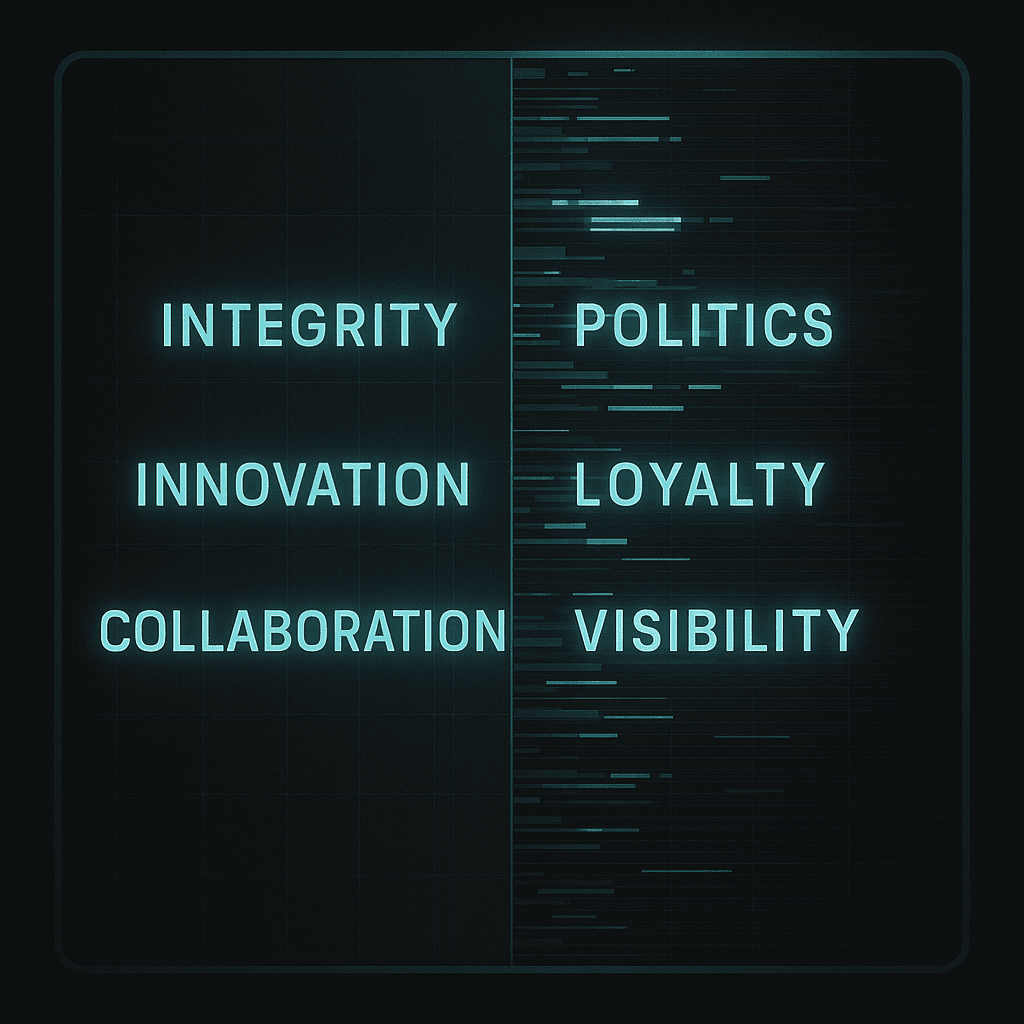 When Systems Speak Louder Than Leaders: The Hidden Economy of Organizational Signals
When Systems Speak Louder Than Leaders: The Hidden Economy of Organizational Signals
In most organizations, leadership conversations revolve around values.
Integrity. Collaboration. Innovation.
They’re beautifully framed, repeated in every strategy deck, and sometimes even printed on walls.
But the real culture isn’t written there.
It’s encoded in what the system rewards.
Every company has two economies:
The spoken one - made of stated values and policies.
The silent one - made of rewards, recognition, and consequences.
When these two fall out of sync, a Reward Rift opens up.
People stop listening to what leaders say and start decoding what the system signals.
A promotion for “loyalty” over competence tells the team that alignment matters more than performance.
A high-visibility project rewarded for presentation polish rather than impact tells everyone that perception trumps progress.
An employee who raises uncomfortable truths but gets sidelined learns that silence, not courage, ensures survival.
No one sets out to design this gap.
It forms slowly - decision by decision, quarter by quarter, until the organization’s stated values become background noise.
Consider a common example: promotion decisions.
You announce that innovation is a core value.
But the person promoted is the one who plays it safe, avoids failure, and never challenges the status quo.
The message received? Stability matters more than experimentation.
Culture shifts not when people disobey leadership, but when they start obeying the wrong signals.
It’s not cynicism that drives disengagement.
It’s pattern recognition.
Most leaders don’t notice misaligned signals because systems look healthy on paper. KPIs are green. Surveys are positive.
But signals are felt, not measured.
Employees see who gets promoted, who gets access, whose mistakes are forgiven, whose ideas travel.
These micro-signals compound into cultural memory.
And that memory eventually overpowers any speech about transformation or values.
By the time leaders sense the erosion, it’s already embedded in how people think, speak, and decide.
Organizations often respond by rebranding values, launching culture initiatives, or running leadership programs.
But you can’t fix a Reward Rift with communication.
You fix it with alignment - when what’s rewarded, recognized, and repeated truly reflects what’s said.
Ask any employee what gets people ahead in their company.
Their answer.. spoken or not - is the culture.
If your systems promote the opposite of your slogans, people will always follow the system.
Because systems are consistent. Slogans aren’t.
Repairing a Reward Rift doesn’t require new values.
It requires honest audits of the invisible economy inside your organization:
Who gets promoted, and why?
What behaviors are quietly protected or excused?
What’s celebrated most - activity or impact?
Until leaders can answer these questions with clarity and courage, culture will remain an accidental byproduct of convenience.
The organizations that thrive aren’t the ones with the best messages.
They’re the ones whose signals match their promises, where rewards tell the same story the values claim to.
Because in the end, systems always speak louder than leaders.
Tags: Leadership, Change Management, Transformation
 Transformation Dies in the Parking Lot
Transformation Dies in the Parking Lot
Why symbols, not slogans, decide whether change sticks
The handbook said: “We value all employees equally.”
But the executive parking spots told a different story.
So did the VIP elevator.
The restricted dining room.
The “all-hands” where not all hands got to speak.
Every morning, employees walked past reserved spaces in the heat.
Every lunch, they watched leaders disappear behind frosted glass.
Nobody complained.
Everyone noticed.
Because culture isn’t built by what leaders say.
It’s built by what leaders signal.
And when signals contradict words, trust doesn’t just weaken - it evaporates.
This is what I call Symbol Theater:
Performing equality while practicing hierarchy.
Preaching transparency while reserving privilege.
Declaring values in print while disproving them in practice.
In transformation, Symbol Theater is fatal.
Many leaders believe transformation succeeds or fails because of strategy. They pour time into crafting roadmaps, drafting communications, and rolling out workshops. But the biggest obstacles to transformation are often invisible - and symbolic.
Take one global organization I worked with. They announced a “One Team” strategy to break down silos. The words were inspiring, the change program carefully designed. But in the first steering meeting, the leaders sat in their usual corners of the room - finance on one side, operations on the other, HR at the back. No mixing. No “one team.”
The message was clear: we may say we’re one, but we’ll act as many.
Within six months, the transformation lost steam. People complied with the mechanics of the program, but nobody believed the spirit of it. What killed it wasn’t lack of vision or resources. It was the symbolism of leaders clinging to old boundaries.
Humans are meaning-seeking creatures. Long before we parse corporate strategy decks, we notice who gets invited into a room, who gets the corner office, who gets to speak uninterrupted.
That’s why symbols carry more weight than slogans:
A leader can declare, “We’re transparent,” but if promotions happen behind closed doors, the system signals secrecy.
A CEO can insist, “We’re flat,” but if there are reserved parking spots for executives, the asphalt says otherwise.
A transformation team can preach agility, but if risk-taking is punished, the culture signals caution.
Employees always believe what they see over what they hear. Transformation collapses when the two don’t align.
The damage isn’t just cultural. It’s operational.
When employees see a contradiction between words and symbols, three things happen:
Trust erodes. People stop believing the story. Without belief, transformation becomes compliance at best, resistance at worst.
Energy drains. Cynicism sets in. Why give your best when leadership isn’t walking the talk?
Momentum stalls. Projects move more slowly, risks aren’t surfaced, and innovation dies in silence.
By the time this shows up in engagement surveys or exit interviews, it’s already too late.
The strongest leaders I’ve seen don’t just change structures and systems. They reset symbols.
Here are three practical ways to start:
Don’t review your handbook. Review your hallways.
Who gets the best parking spots?
Who sits at the table, and who doesn’t?
Who speaks in meetings, and who stays silent?
These everyday decisions are silent culture-shapers. Leaders who ignore them accidentally script resistance into the system.
If your goal is inclusivity, check if your symbols exclude.
If your goal is agility, check if your symbols punish risk.
If your goal is collaboration, check if your symbols reinforce silos.
Transformation begins not with bold statements but with quiet alignment.
Employees remember what leaders do long after they forget what leaders said.
When a CEO takes the same shuttle as frontline employees, that symbol matters.
When a senior executive stays silent in a meeting to let junior voices speak, that signal resonates.
When leaders are transparent about failures as well as successes, that honesty builds trust.
Signals like these create belief. And belief is the fuel of transformation.
If you’re driving transformation, ask yourself:
What symbols in my organization undermine the change I want?
Where do my actions, privileges, or rituals contradict the culture I describe?
What one signal could I change tomorrow that would speak louder than any speech?
Because transformation isn’t decided in boardrooms.
It’s decided in parking lots, meeting rooms, and cafeterias - where the smallest symbols either reinforce or erode the biggest ambitions.
Transformation is never just about strategy, systems, or processes. It’s about signals.
The organizations that thrive are those where symbols and strategy are aligned - where what’s written in the handbook is visible in the hallways.
Because at the end of the day, employees don’t just follow plans.
They follow proof.
Tags: Leadership, Culture, Transformation
 The Hidden Trap of Transformation: Why “Solution Importing” Always Fails
The Hidden Trap of Transformation: Why “Solution Importing” Always Fails
When organizations talk about transformation, the conversation usually starts with confidence. A new leader arrives with a proven playbook: the framework that “saved” their last company, the process that “delivered results” before, the structure that once “transformed everything.”
Copy. Paste. Execute.
But here’s what often gets skipped: understanding why this place is different.
Because in the urgency to deliver results, context feels like a delay. Listening feels like overthinking. Quick wins feel like progress. And so, leaders fall into what I call “Solution Importing.”
Solution Importing happens when leaders bring answers to questions they never asked. It’s the act of applying yesterday’s solutions to today’s problems without considering the ground reality.
And it fails every time.
Solutions don’t solve the real problems.
People resist because they weren’t heard.
Short-term gains create long-term damage.
Transformation isn’t about replication. Context, culture, and constraints matter. When these are ignored, even the best ideas become mismatched.
People don’t resist change itself.
They resist being ignored.
And when employees feel their voice doesn’t matter, they disengage not just from the project, but from the leadership driving it.
Transformation leaders who succeed do something different:
They spend time in the mess before trying to clean it up.
They ask more questions than they answer.
They understand before they implement.
Not because it’s faster.
But because it lasts.
Context isn’t the enemy of speed.
It’s the foundation of success.
Instead of asking:
“How do I apply what worked before?”
Ask:
“What is unique about this organization that changes how solutions must be designed?”
Because transformation isn’t about moving faster.
It’s about building systems that can stand the test of time.
And that difference determines whether your change disappears in five months - or survives the next five years.
Tags: Leadership, Change Management, Transformation
 Process Theater: How Fear Builds Bureaucracy and Kills Momentum
Process Theater: How Fear Builds Bureaucracy and Kills Momentum
Fear as the Architect of Systems
In many organizations today, processes are still not designed for speed or trust. They are built for protection - of roles, of egos, of careers.
Fear is the architect, and bureaucracy is the result.
Over time, the accumulation of unnecessary steps, stakeholders, and approvals becomes so normalized that no one remembers why they exist.
I call this phenomenon “Process Theater.”
The Pattern is Always the Same
Across industries, the same dysfunctional cycle emerges:
More approvals? Less actual oversight.
More stakeholders? Less accountability.
More steps? Less clarity on purpose.
On the surface, these additions look like safeguards.
In reality, they are performances - rituals of control that create the illusion of governance while suffocating agility.
The Hard Truth Leaders Don’t Admit
That six-signature expense process? It isn’t compliance. It’s control.
That endless “stakeholder alignment” meeting?
It isn’t collaboration. It’s cover.
Organizations rarely call it what it is because to do so would force leaders to confront the fear driving their decisions: “What if something goes wrong?”
Those six words have created more value-destroying, career-protecting systems than any competitor ever could.
The Cost of Illusion
- Process Theater doesn’t manage risk - it manages egos.
- It quietly kills momentum, innovation, and trust.
- It signals to employees that leaders don’t trust them to use judgment.
And it makes organizations slower than their competitors, not because of market forces, but because of self-inflicted complexity.
Designing for Trust Instead of Control
The most effective companies don’t eliminate processes. They redesign it.
They dare to ask the uncomfortable question: “What if we just stopped doing this?”
Because if a process can’t be defended on value, it doesn’t belong.
The true test is simple:
If you stopped doing it tomorrow and nothing meaningful broke, it wasn’t safeguarding the business. It was a theater.
The Leadership Imperative
Leaders who want to transform dysfunction into function must shift the design principle from control to trust. That requires courage, clarity, and accountability:
Courage to simplify instead of layer.
Clarity on what truly protects value.
Accountability for outcomes, not appearances.
Organizations that master this balance don’t just move faster. They build cultures where momentum, responsibility, and innovation thrive.
And in today’s environment, speed is not a luxury.
It’s survival.
Tags: Leadership, Change Management, Transformation
 The Silent Cost of Excusing Entitlement in Leadership
The Silent Cost of Excusing Entitlement in Leadership
We don’t hire toxic leaders.
We create them.
Not with intent, but with silence.
I once watched a promising young leader transform almost overnight. He was smart, ambitious, collaborative - the kind of person every organization wants to fast-track. We gave him broader responsibilities, invested in his development, and placed him on the leadership pipeline.
Then came the shift.
He began demanding perks seasoned directors had earned over decades:
a car, a driver, a personal assistant.
He started treating junior employees as if their role was to manage his workload, not their own.
When I challenged him, his response was telling:
"My time is more important than theirs."
That moment should have triggered a conversation.
A reality check.
A course correction.
Instead, it triggered silence.
We told ourselves he was “still learning.”
That we shouldn’t “kill his confidence” so early.
That potential outweighed the behavior in front of us.
The cost?
Four team members resigned - not for better roles, but because of him.
Productivity collapsed.
Trust eroded.
Eventually, he left too. But the scars remained. It took nearly two years to rebuild what was lost in one.
That experience cemented a truth I now carry everywhere:
Entitlement left unchallenged compounds into toxicity.
Every time we excuse poor behavior in the name of “potential,” we’re not growing leaders.
We’re growing tyranny.
This is why I now use what I call the 48-Hour Rule.
If entitlement shows up - even once - I give feedback within 48 hours.
No exceptions. No excuses. Not even for “top talent.”
Because the cost of one uncomfortable conversation is always less than the cost of repairing a broken team.
As leaders, our role isn’t to protect egos. It’s to protect cultures.
So the real question is this:
What truth does your top talent need to hear but you’re still avoiding?
Tags: Culture, Change Management, Transformation
 Why Blame Culture is the Silent Killer of Performance
Why Blame Culture is the Silent Killer of Performance
And the real damage doesn’t come from shouting or confrontation.
It comes from silence.
When employees believe mistakes will be punished or humiliating, they stop speaking up. They work around problems instead of surfacing them. Over time, silence becomes the culture, and that’s when performance begins to erode.
Blame creates hesitation. People pause before admitting errors.
Hesitation breeds silence. Teams decide it’s safer not to share.
Silence kills performance. Innovation, initiative, and trust all shrink.
In one team I worked with, a talented colleague spent three days quietly fixing a small error. Not because it was difficult, but because the last person who admitted a mistake had been publicly torn apart. The real loss wasn’t time. It was trust.
If it’s so destructive, why does blame culture survive? Because it feels deceptively effective.
It gives the illusion of control. Find the person, assign the fault, close the loop.
It misplaces accountability. Individuals are punished, while flawed systems go unexamined.
It rewards fear-based leadership. Leaders mistake silence for compliance when in reality it’s disengagement.
In the short term, it looks like discipline. In the long term, it undermines performance.
A culture of silence has predictable consequences:
Lost innovation. Nobody risks fresh ideas.
Shrinking initiative. Teams wait for permission instead of acting.
Talent attrition. High performers quietly exit for organizations where honesty is safe.
The irony is that leaders often believe they’re “raising standards” by being tough on mistakes. In reality, they’re draining the very energy that drives transformation.
Leaders who want resilient, high-performing teams need to reframe their response to mistakes. Here’s how:
From Blame to Systems Thinking
Ask: “Where did the process break down?”
Treat mistakes as signals to improve systems, not as failures to punish.
From Criticism to Curiosity
Your first reaction sets the tone.
Replace “Who’s at fault?” with “What made sense at the time?”
From Perfection to Honesty
Reward people for speaking up.
You’re not celebrating failure - you’re celebrating trust.
These shifts don’t make mistakes disappear. They make them visible, which is the only way organizations can actually learn from them.
The real threat isn’t failure. It’s the silence that follows.
Leaders who create trust in the face of mistakes aren’t lowering standards; they’re raising performance. Because when people feel safe to tell the truth, organizations don’t just avoid decline. They build resilience, adaptability, and long-term strength.
The imperative is clear: stop asking how to prevent mistakes, and start asking how to prevent silence.
That’s the shift that turns teams from fragile to future-ready.
Tags: Leadership, Culture, Transformation
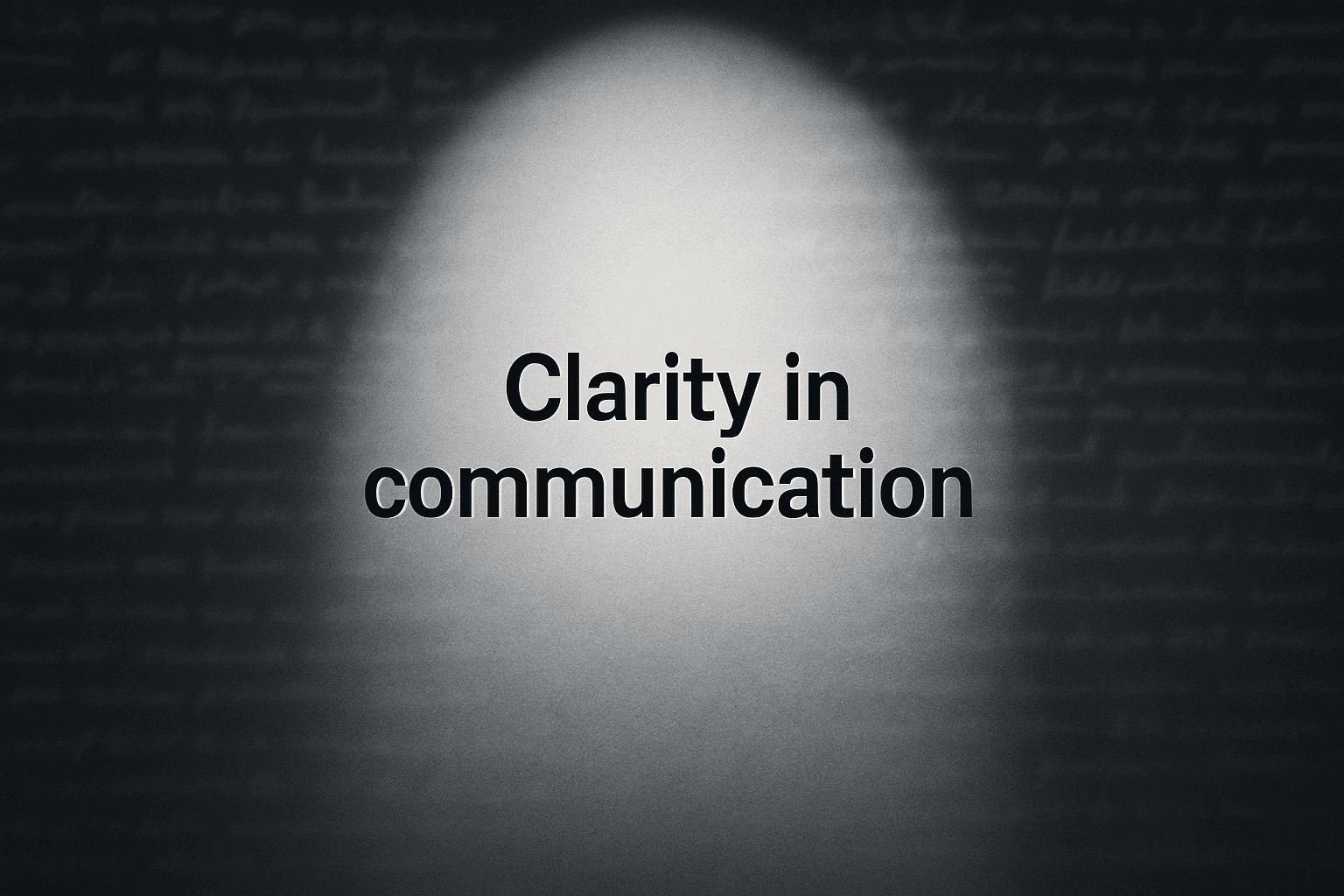 Clarity is Your Credibility: Why Leaders Lose Trust When Their Message Gets Lost
Clarity is Your Credibility: Why Leaders Lose Trust When Their Message Gets Lost
We used to print his emails to understand them.
I’m not kidding.
One of my old bosses would send… novels.
Emails that read like essays.
Two pages minimum, no clear point.
No context.
No call to action.
We’d actually print them out, grab highlighters, and decode them like ancient scrolls.
And I’d think:
If this much effort goes into writing it and we still don’t know what to do… something’s truly broken.
But the confusion didn’t end with emails.
Later, I worked with leaders who’d speak for 10 minutes straight… and say nothing.
Investors left without direction
Board members stayed silent
Teams walked out with more questions than answers
That’s when I started seeing the pattern:
If people can’t follow your message, they won’t trust your leadership.
It’s not about sounding smart.
It’s about being understood.
The Leadership Cost of Confusion
In high-stakes environments, ambiguity creates three dangerous outcomes:
Misalignment – Teams interpret instructions differently, creating conflicting priorities.
Delays – People waste time clarifying instead of executing.
Erosion of trust – Stakeholders begin to doubt capability and intent.
My Rules for Message Clarity
→ Start with the ask: “Decision needed by Friday” beats “Just a quick update.”
→ Provide context: Why does this matter right now?
→ Be brutal with fluff. Ruthless with ambiguity.
Whether it’s an email to your team or a presentation to the Board, clarity isn’t a “soft skill.”
It’s leadership infrastructure. Without it, everything else fails.
Because in the end, your words aren’t just communication.
They’re a signal.
And those signals tell people whether to follow you… or quietly disengage.
Tags: Leadership, Culture, Transformation
 When Private Alignment Isn’t Public: The Hidden Saboteur of Transformation
When Private Alignment Isn’t Public: The Hidden Saboteur of Transformation
“We were aligned. Until the meeting started.”
Every transformation leader has had that moment.
The private green light. The public hesitation.
The plan that made sense - until the room filled up.
I used to assume that alignment in one-on-ones meant support in public. That a nod in private was a firm “yes” I could build on.
I was wrong.
What I’ve seen over time is this:
Many people don’t say “yes” to the change.
They say “yes” to avoid discomfort.
To avoid being the lone voice.
To protect their image.
That’s not alignment.
That’s survival.
And when we mistake the two, transformation quietly derails.
Because the cost of false alignment isn’t just an awkward meeting.
It’s lost credibility.
It’s a confused team.
It’s change initiatives that stall without warning.
In my work leading transformation across organizations, I’ve learned to listen between the words.
To look for what’s not being said.
And to ask a simple question before moving forward:
“Can I bring this to the wider group as our collective decision?”
If there’s hesitation, the answer was never really “yes.”
This matters because transformation doesn’t just depend on vision.
It depends on clarity of commitment.
Not posturing. Not passive agreement.
But clear, confident, public support, especially when stakes are high.
We talk a lot about resistance to change.
But often, the bigger risk isn’t resistance.
It’s pretend agreement.
And if we don’t address that signal gap early, we end up leading alone.
Not because the strategy was wrong -
But because the support wasn’t real.
Tags: Leadership, Culture, Transformation
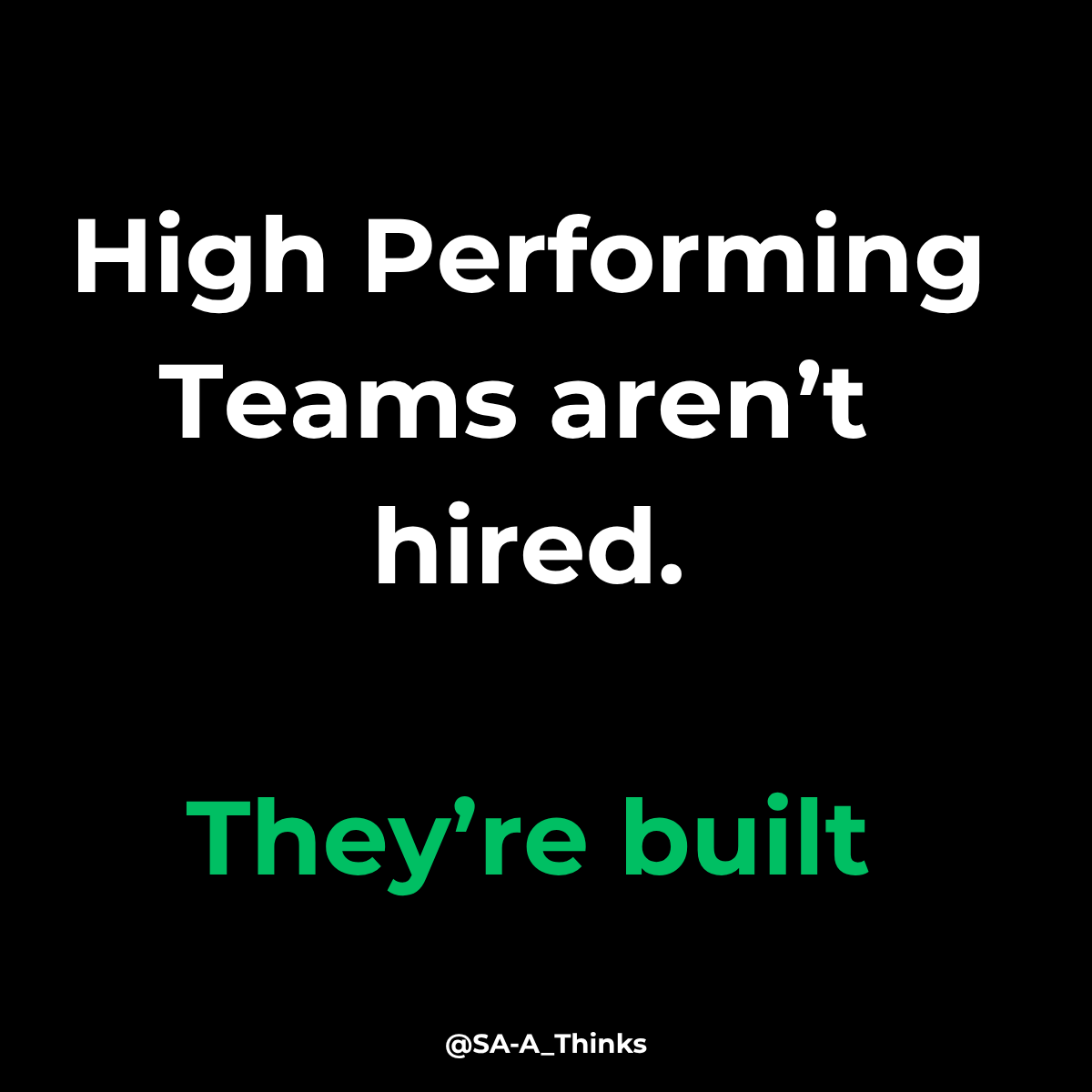 High-Performing Teams Aren’t Hired. They’re Built.
High-Performing Teams Aren’t Hired. They’re Built.
Everyone wants a high-performing team.
Very few want to build one.
They want the person who’s done it all before.
Someone who can hit the ground running.
No learning curve. No mistakes. No questions.
But performance doesn’t come pre-installed.
It’s built through the messy, uncomfortable, in-between moments.
When you roll up your sleeves instead of watching from the sidelines.
When you co-create, not just assign.
When you say, “Let me show you how,” instead of, “Why didn’t you already know?”
Sometimes, that means building the first deck with them.
Writing the first tough email together.
Sitting through the hard conversations shoulder to shoulder.
Not because they can’t.
But because they haven’t had the reps yet.
That’s not spoon-feeding.
That’s leadership.
Because high performance isn’t a hiring goal.
It’s a development process.
It’s something you grow...with time, with trust, with intent.
Here’s how strong teams are actually built:
→ Show them what “good” looks like
→ Create space for autonomy
→ Stick around long enough to see them own it
I lead this way today because someone once did it for me, when I didn’t yet have the confidence, clarity, or voice.
They didn’t just expect me to rise.
They gave me the ground to stand on.
That’s the kind of leadership I’ve seen work.
And it’s the kind I build.
Every. Single. Time.
Tags: Leadership, Culture, Transformation
 When Leadership Becomes a Bottleneck
When Leadership Becomes a Bottleneck
We don’t always call it micromanagement.
Sometimes, it’s disguised as rigor.
Or precision.
Or high standards.
But over the years, I’ve come to realize:
What we call control often stems from fear.
The fear of being blamed for mistakes.
The fear of not being in control.
The fear of letting go.
And fear, when it leaks into leadership, doesn’t just slow progress. It stifles growth.
I once worked under a leader who insisted that nothing, not even a minor update, be shared without her explicit sign-off. Every message, every deck, every email passed through her.
The result?
The team didn’t fail.
But we didn’t move either.
People hesitated before speaking.
They waited for permission.
They second-guessed their own judgment.
Eventually, they stopped trusting themselves altogether.
That’s what happens when leadership is built around control:
You don’t just delay decisions.
You shrink confidence.
You create dependence.
And ironically, the more you try to “own” everything as a leader, the less your team owns anything.
So now, when I lead, I ask myself hard questions:
Why does this process still rely on me?
What am I afraid will happen if I let go?
Who’s already ready but waiting for space to lead?
Because the truth is:
Leadership isn’t about how much flows through you.
It’s about how much flows without you.
If your team is moving slowly, start by asking what you’re still holding onto too tightly.
It might not be about speed.
It might be about trust.
Tags: Leadership, Change Management, Transformation
 What If “It’s Working Fine” Is Actually Costing You?
What If “It’s Working Fine” Is Actually Costing You?
In almost every organization I’ve worked in, I’ve seen it:
A process that’s been running for years, rarely questioned - because “it works.”
It doesn’t break.
But it doesn’t build either.
And over time, that quiet comfort becomes dangerous.
We confuse stability with strength.
We protect old ways of working like they’re sacred.
But what we’re really protecting…
is underperformance.
When no one’s actively complaining, we assume everything’s fine. But under the surface, inefficiencies pile up. Morale dips. Decisions slow. Energy gets drained by outdated handovers, clunky approvals, or tools that once made sense - but no longer serve their purpose.
The irony?
By not questioning what’s “working,” we end up normalizing mediocrity.
Most of my career has been about walking into processes no one noticed—until the cracks showed.
What I’ve learned is this:
Real transformation rarely starts with a shiny new tool or a better dashboard.
It starts with the courage to look again.
To challenge what no one’s questioning.
When I audit a process, here’s what I always ask:
Where does the friction begin?
I trace the process upstream, before the symptoms show.
Who benefits? Who’s burdened?
Often, the structure protects legacy power while quietly overloading others.
What’s really stopping change?
Sometimes it's ego. Sometimes it’s history. Most often, it’s just habit.
And finally—
Is this serving our customer or stakeholder, or just surviving?
If you’re serious about transformation, don’t just ask:
“What’s broken?”
Ask:
“What are we tolerating just because it’s familiar?”
That’s where the real work begins.
Think of one process in your team that seems “fine.”
Then ask yourself →
Is it actually effective, or just familiar?
Let that question sit.
It might reveal more than you expect.
Tags: Leadership, Culture, Transformation
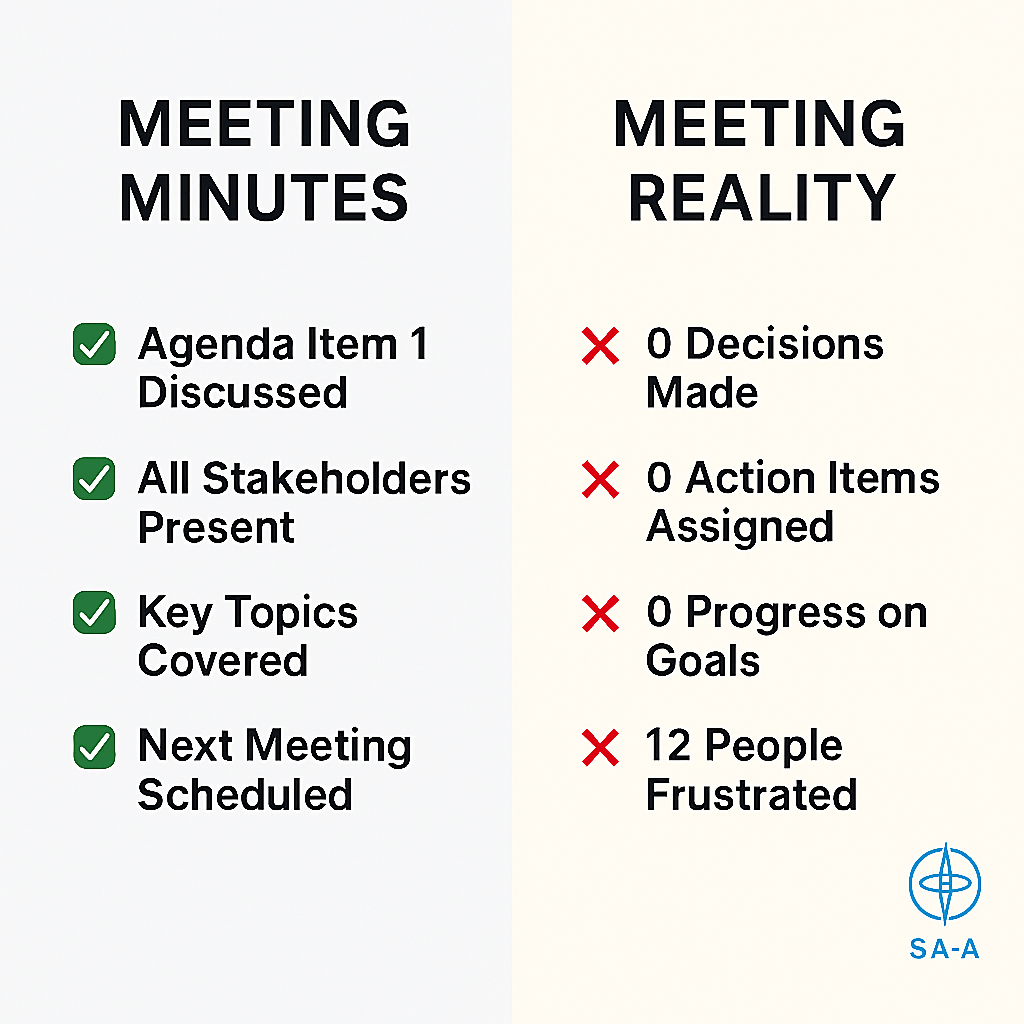 When Everyone Attends but No One Participates: The Hidden Cost of Unprotected Meetings
When Everyone Attends but No One Participates: The Hidden Cost of Unprotected Meetings
When Everyone Attends but No One Participates: The Hidden Cost of Unprotected Meetings
Every Tuesday at 2 PM, the same 12 people walked into the same conference room to discuss the same agenda.
Point 1 was always the starting point.
But we never made it past that.
Instead, it unraveled into cross-functional complaints, outdated grievances, and irrelevant debates.
Two hours later, the only consistent outcomes were:
No clarity
No decisions
No next steps
Just 12 drained people silently wondering: Why are we even here?
Most meeting failures aren’t due to poor content or weak facilitation skills.
They fail because no one holds the line on why the meeting exists in the first place.
No one enforces relevance.
No one interrupts the tangents.
No one calls time on distractions.
No one reminds the room: What are we actually here to achieve?
This isn’t a tactical slip. It’s a strategic erosion.
And over time, it has a compounding effect — not on calendar space, but on contribution energy.
Here’s what actually erodes in meetings that lack discipline:
Trust: People start withholding, not because they lack ideas, but because they’ve stopped believing anything will change.
Energy: The most capable contributors mentally check out, not out of laziness, but as a self-preservation tactic.
Accountability: When there are no real outcomes, there’s no pressure to show up with intent, just to show up at all.
And slowly, the organization starts rewarding attendance over impact, visibility over value, speaking time over contribution quality.
Participation isn’t about speaking up.
It’s about believing your input matters.
If the system keeps demonstrating that it doesn’t, people adapt accordingly.
This is why silent meetings aren’t a people problem.
They’re a design problem.
And like all broken systems, it starts with good intent… and dies in poor protection.
What exactly are we trying to move forward in this meeting — and is a meeting the best way to do it?
Who needs to be here to move it forward, not just to listen?
What does successful participation look like for each person in the room?
And once the meeting starts, protect that intent like a non-negotiable.
Because if you don’t, the meeting will be hijacked.
Not by bad people, but by the absence of boundaries.
Let’s be honest - people are tired.
Not because they’re lazy or disengaged.
But because systems have trained them that their time isn’t respected.
We often talk about inclusion in terms of diversity.
But inclusion also means creating spaces where contribution feels worth the effort.
And that begins - quite simply - by protecting the purpose of the room.
Tags: Leadership, Culture, Transformation
 When Ideas Stop Flowing: The Hidden Cost of a Silent Team
When Ideas Stop Flowing: The Hidden Cost of a Silent Team
When teams stop speaking up, most leaders notice too late.
By the time ideas stop flowing, something deeper has already shifted.
In meetings, only the same two or three voices speak.
The rest, head down and eyes averted, are technically present but emotionally checked out.
You ask a question, and silence follows. Unless someone is directly prompted, few speak.
The problem isn’t that the team has nothing to say.
It’s that they’ve stopped believing their ideas will go anywhere.
And when that happens, you lose more than innovation.
You lose momentum. You lose ownership. You lose the pulse of your people.
Three silent signals your team has stopped contributing:
They only speak when asked direct questions.
“Let’s table it” is your default response to new ideas.
The same 2–3 voices dominate every conversation.
Individually, these signs seem minor. But together, they signal a quiet withdrawal.
People stop challenging decisions.
They stop thinking creatively.
They stop taking ownership.
It’s not disengagement in the traditional sense.
It’s self-protection.
Because when psychological safety erodes, when contribution feels performative or pointless, people preserve their energy.
They show up. But they don’t show themselves.
Why this matters more than ever
In a time of constant transformation, your biggest asset isn’t a new system, tool, or framework.
It’s a team still willing to contribute, not just comply.
But contribution requires trust.
Trust that ideas will be heard, not hijacked.
Trust that speaking up won’t backfire.
Trust that new thinking won’t be shut down before it’s tested.
Without that trust, even the smartest people go quiet.
So what can leaders do to break the silence?
Stop hoarding airtime. Make space in meetings for less vocal voices. That means managing dominant contributors and inviting quieter ones without putting them on the spot.
Reward insight, not hierarchy. Normalize dissenting views, especially when they come from junior staff or unexpected places.
Act visibly on feedback. Even small actions based on employee input can rebuild belief that ideas matter.
Real transformation isn’t driven by those who speak the most.
It’s powered by those who feel safe enough to say what others won’t.
Final thought
Ideas don’t die.
They just stop being shared.
If you’re leading a change agenda, your first job isn’t pushing performance.
It’s protecting the conditions where contribution can still exist.
Because once your team learns their voice doesn’t matter…
They won’t waste their breath.
Tags: Leadership, Change Management, Transformation
 When Metrics Mislead: Why Hitting Targets Doesn’t Mean You’re Winning
When Metrics Mislead: Why Hitting Targets Doesn’t Mean You’re Winning
I once sat in a business review where everything looked great on paper.
The service team had hit its targets.
The back office was reporting green across all SLAs.
NPS scores were stable.
Escalations were down.
And yet…
Customers were leaving.
Not dramatically.
Not with angry emails or social media outrage.
Just quietly.
One by one.
It didn’t make sense - until it did.
The problem wasn’t performance.
It was perception.
We love our dashboards.
Green means good. Red means fix it. Simple, right?
Except real life, and real customers don’t operate in silos.
One team’s “on target” might still be part of a journey that’s deeply frustrating for the customer.
Because customers don’t judge your departments.
They judge the total experience.
No one says:
“Support was fast, but billing was slow, so I’ll give the company 50% credit.”
They say:
“This company didn’t deliver.”
This is the real trap of modern performance management:
Every team does its job.
No one owns the outcome.
We measure tasks, timelines, and targets.
But we rarely ask:
“Did this feel like a win, to the one person that matters most?”
This isn’t an argument against metrics.
I track them daily.
But I’ve learned to ask one extra question:
“If I were the customer, would this experience make sense?”
And when the answer is no, it’s not a failure.
It’s feedback.
That’s where transformation begins.
Fixing one team’s process won’t save a broken customer journey.
We need to zoom out and ask harder questions:
Are we optimizing for internal convenience or external value?
Are our metrics measuring motion or impact?
Are we rewarding departments for performance… or the business for outcomes?
When you look at transformation through that lens, the real work becomes clear.
It’s not about doing more.
It’s about seeing better.
Great leaders don’t just chase KPIs.
They connect the dots across systems.
They see the space between green boxes on a dashboard and ask what’s being missed.
Because sometimes, what looks like progress is just well-documented inertia.
And if your customers are quietly leaving, it might not be your numbers that need fixing.
It might be your narrative.
Transformation doesn’t begin with strategy decks or new tools.
It begins the moment we ask the uncomfortable question:
“Are we solving the right problem?”
Tags: Customer Experience, Business Strategy, Transformation
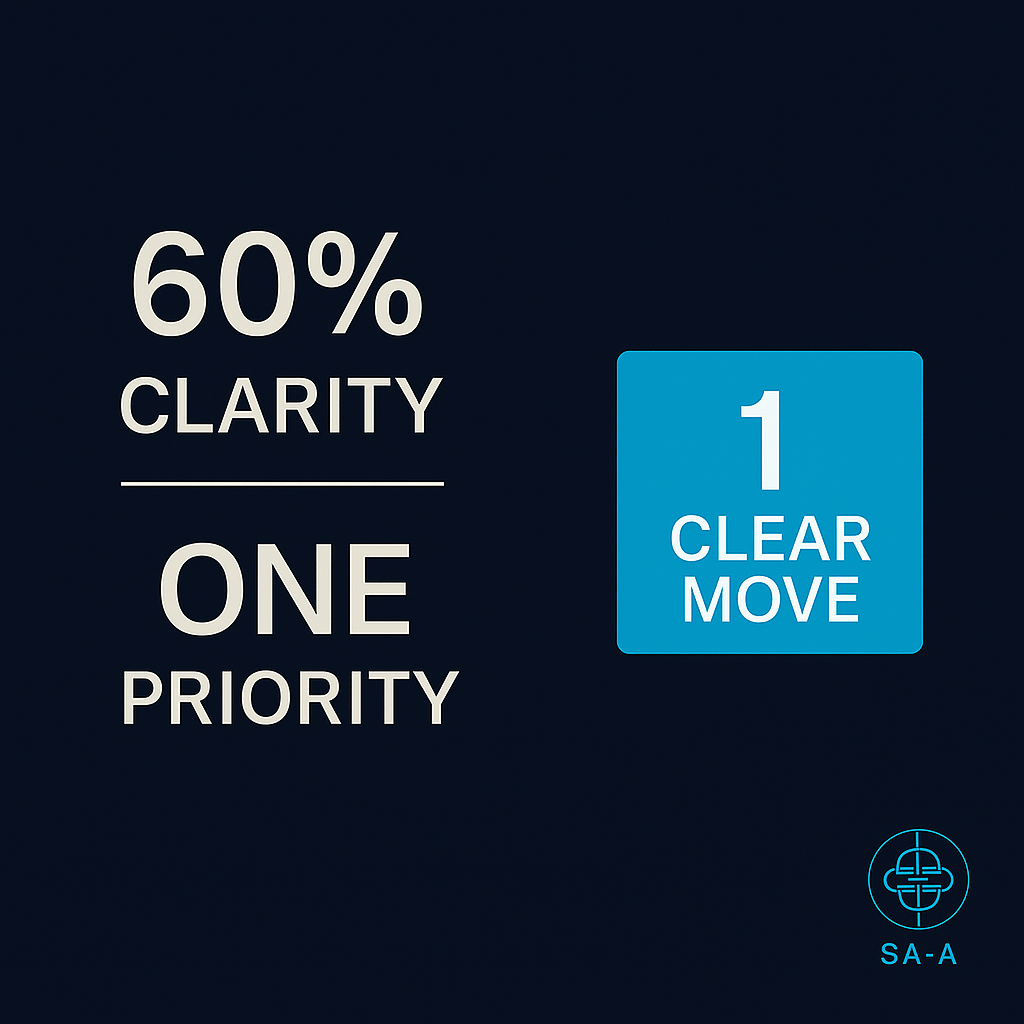 Decisiveness Isn’t a Leadership Trait. It’s a Survival Strategy.
Decisiveness Isn’t a Leadership Trait. It’s a Survival Strategy.
Transformation doesn’t fail because people don’t care.
It fails because they don’t know where to start.
I’ve worked across banking, marine offshore, and complex shared services. And in every transformation effort, one pattern repeats:
Urgent goals.
Overstretched teams.
Endless meetings trying to fix everything at once.
The result?
Inertia.
Because the more we try to move everything, the less we move at all.
I first learned this during my Six Sigma Green Belt training at GE Capital. We were taught the Pareto Principle: the 80/20 rule.
Back then, it felt like a project management tool.
Today, I see it as a leadership mindset.
Focus on the 20% of problems causing 80% of the friction.
Don’t solve everything.
Solve what matters most—and solve it well.
That single discipline has made the difference in every high-stakes transformation I’ve led since.
The biggest myth in transformation is this:
"Once we’re clear, we’ll act."
But real-world transformation rarely gives you perfect clarity. The stakes are too high. The pressure is too constant. The variables shift too fast.
So leaders wait. Teams stall. Projects drag.
The irony?
Clarity often comes after the first move, not before.
Let’s be clear: decisiveness isn’t about gut calls or bravado.
It’s about choosing impact over noise, even when you don’t have all the data.
Decisiveness means:
Acting when you’re only 60% clear
Prioritizing what unlocks momentum
Letting some fires burn, so the right one gets extinguished
I’ve been in boardrooms where everyone could sense the urgency… but no one wanted to name it.
I’ve seen projects with perfect rollout plans collapse under the weight of indecision.
And I’ve also seen what happens when one person makes a clear, imperfect move that shifts everything.
If you’re in the middle of change right now, pause and ask:
What’s the one decision that would unblock progress?
What’s the one thing you’ve been waiting to get 100% clear on… that could be actioned at 60%?
And what’s one thing you’re solving that could wait?
That’s where real movement begins. Not with perfection. With a deliberate, timely act.
We love stories of sweeping transformation. But in real life?
The turning point is often a single, sharp choice that breaks the cycle of waiting.
In high-stakes work, decisiveness isn’t a trait reserved for confident personalities.
It’s a strategic skill.
A survival mechanism.
A professional responsibility.
And it’s what separates transformation that stays stuck… from transformation that actually happens.
Tags: Leadership, Change Management, Transformation
 Why Transformation Fails When We Ignore the Human Lens
Why Transformation Fails When We Ignore the Human Lens
In every transformation initiative, there’s a hidden inflection point.
It’s not found in the strategy deck.
It doesn’t emerge in the implementation timeline.
It starts when someone pauses long enough to ask the question most teams avoid:
“Why are we still doing it this way?”
Too often, transformation efforts bypass this pause entirely, jumping straight to execution, often powered by tools and systems meant to streamline what was never properly examined.
I’ve seen organizations roll out enterprise systems - HRMS, ERP, collaboration tools—with bold promises. Six months later, many of those same teams quietly revert to spreadsheets. Spreadsheets, they trust. Workarounds they built. Because the system didn’t solve what they were actually struggling with.
The problem wasn’t the tech.
The problem was what no one stopped to question:
The workflow that no longer made sense.
The invisible handoffs.
The friction teams had normalized.
Transformation doesn’t fail because we didn’t automate fast enough.
It fails when we skip the human pause that precedes clarity.
That pause to decide to see what’s no longer working isn’t just common sense. It’s a behavioral skill. One we rarely teach, reward, or name.
It’s called Ingenuity.
Not innovation.
Not talent.
Not intelligence.
Ingenuity is the ability to move when things are unclear - to find clarity inside complexity and take the first step without a perfect plan.
It begins with a shift in behavior. And over the years, I’ve seen four patterns that make that shift possible: what I now refer to as the Ingenuity C.O.D.E. framework.
Curiosity
Asking the questions others have stopped asking.
Open-Mindedness
Pausing long enough to notice what’s become invisible.
Decisiveness
Making a call before every scenario is mapped out.
Experimentation
Moving forward through small tests before big changes.
In one recent project, the breakthrough didn’t come from the system launch, it came in a small room with a whiteboard, where we mapped out the actual process. No assumptions. No solutions. Just clarity.
That session exposed more value than the system itself ever would have, because we could finally see what wasn’t working.
Transformation is often pitched as forward-looking. Strategic. Tech-enabled. But most of what holds organizations back is behind them in the routines, workflows, and assumptions no one is questioning.
You don’t fix that with better tools.
You fix it by restoring visibility.
And visibility comes from the human discipline to pause, observe, and name what others have accepted for too long.
That’s where transformation really begins.
And that’s where Ingenuity is no longer optional.
If you're leading change, at any level, ask yourself:
What’s one process, system, or behavior that’s still running today… Simply because no one has stopped to question it?
That’s the moment where Ingenuity begins.
And progress follows.
Tags: Leadership, Change Management, Transformation
 Curiosity Isn’t Soft - It’s How Real Change Happens
Curiosity Isn’t Soft - It’s How Real Change Happens
Curiosity Isn’t Soft—It’s How Real Change Happens
Disruption is everywhere.
Yet most teams stay stuck in processes designed for a world that no longer exists.
Why?
Because questioning the status quo often feels like a risk, not a leadership move.
But here’s the thing no one tells you:
Curiosity isn’t soft. It’s how real change happens.
Years ago, I found myself running a nine-week training program in a large organization—heavy slides, heavy compliance, zero flexibility. We were following “the process,” but it felt disconnected from what the business really needed.
One day, I asked out loud:
“Why does this need to take nine weeks?”
My manager didn’t like it.
“Stay in your lane. Just follow the process,” he snapped.
But that question wouldn’t leave me alone.
So I went back, mapped a six-week alternative, and nervously pitched it again. This time, surprisingly, he listened.
We got permission to run a pilot.
Same outcomes.
Three weeks saved.
Tangible business impact.
That single moment of curiosity cracked open my career in transformation.
True transformation doesn’t happen by accident. It follows a pattern - one I now call the Ingenuity C.O.D.E.:
Curiosity – Ask bold questions that challenge “how we’ve always done it.”
Open-Mindedness – Consider unexpected ideas when obvious solutions stall.
Decisiveness – Move forward when you see a better way, even if it’s imperfect.
Experimentation – Test small before scaling big.
Whether you’re redesigning a workflow or rethinking a business model, it starts by challenging what feels "untouchable."
In a world of AI, automation, and accelerated disruption, organizations don’t fail because of external forces.
They fail because of internal inertia - the refusal to question outdated processes, hierarchies, and systems.
The good news?
You don’t need permission to start asking better questions.
The real risk isn’t challenging the system.
The real risk is staying silent while the world moves on.
What outdated process is slowing your team down right now?
What question do you need to ask - even if it feels uncomfortable?
Start there.
Because that single act of curiosity might just spark your next transformation.
Tags: Leadership, Change Management, Transformation
 Ingenuity Isn’t Creativity - It’s the Survival Code
Ingenuity Isn’t Creativity - It’s the Survival Code
Ingenuity isn’t creativity.
It’s strategic survival.
We often celebrate resilience and problem-solving, and rightly so.
But they maintain systems.
Ingenuity reimagines them.
It shows up when:
– A critical process collapses, and someone builds a smarter workaround
– Budget cuts force a team to rethink from scratch, and they find hidden value
– Standard methods fall short - and a new model quietly reshapes how things are done
These aren’t “initiatives.”
They’re survival moments - and they happen more often than we admit.
But here’s the catch:
Most organizations still treat ingenuity as accidental.
Something lucky.
Something extra.
That mindset won’t last much longer.
If disruption is constant, then ingenuity must be built in.
Protected, activated, and rewarded like the essential advantage it is.
I call it:
The survival code of adaptive organizations.
➤ Where are you seeing ingenuity emerge under pressure, and how is it being protected (or not)?
#ThoughtLeadership #BusinessStrategy #OrganizationalIngenuity #IngenuityCODE #FutureOfWork #SAAVoice
Tags: Future of Work, Business Strategy, Transformation
 Comfort Isn’t a Strategy. It’s a Slow Death.
Comfort Isn’t a Strategy. It’s a Slow Death.
Most companies don’t get disrupted by bold new entrants.
They get dismantled - quietly - by their own comfort zones.
Transformation doesn’t fail because people resist change.
It fails because comfort convinces them there’s no need to.
The signs are easy to miss:
Legacy roles that no one challenges.
Outdated processes that run on inertia.
KPIs that are tracked but not respected.
And the most dangerous sentence of all:
“We’ve always done it this way.”
I’ve led transformation through chaos, resistance, and urgent pivots.
And what I’ve learned is this:
True change begins when you confront comfort, not just complexity.
So ask yourself:
If your company had to rebuild today, what would you retire first?
And what are you still protecting… just because it feels familiar?
Tags: Future of Work, Change Management, Transformation
 Title: Why Change Fails - and What to Do About It?
Title: Why Change Fails - and What to Do About It?
Title: Why Change Fails — and What to Do About It
Change doesn’t fail because people resist it. It fails because leaders don’t align people, systems, and strategy.
Resistance is rarely emotional. It’s usually a signal—a symptom of confusion, exclusion, or poor follow-through. When strategy is defined in isolation, when systems aren't adapted to support execution, and when people are expected to figure things out on their own, the result is predictable: stalled momentum, wasted effort, and transformation theatre.
In two recent short videos, I broke down what really derails change and what leaders can do to fix it. Here's the integrated view.
1. Resistance Isn't the Problem
We often label pushback as "resistance to change," when in reality, it's a response to:
Unclear decision rights
Lack of communication follow-through
Misaligned structures and outdated KPIs
People don’t resist change because they’re lazy or negative. They resist when they can’t see how the change makes sense, when they weren’t part of shaping it, or when the support structure is missing.
It’s not emotional resistance. It’s operational misalignment.
2. What Actually Helps Change Land
There are plenty of change models out there, but two continue to stand out in my work:
Prosci’s 3-Phase Process
A clear approach to managing the people side of change
Focuses on awareness, desire, knowledge, ability, and reinforcement
McKinsey’s 7S Framework
Aligns strategy, structure, systems, skills, style, staff, and shared values
Particularly useful for understanding how change ripples across an organization
I think of models like GPS. They’re helpful for navigating from point A to B - but only if you know where you’re starting and what the terrain looks like. And just like with travel, no single route fits every journey.
In practice, I often blend models. Prosci helps clarify the people dimension, while 7S brings structure to the organizational side. Used together, they bring the kind of clarity and context most change efforts lack.
3. Strategy is Not a Slide. It's a System.
In many transformations, the ambition is real. The decks are impressive. The town halls are inspiring.
But execution crawls. Not because people didn’t care. But because the foundation wasn’t aligned.
If your incentives reward the old behavior, if your systems are still optimized for yesterday’s risks, and if your org design creates confusion instead of clarity - change doesn’t land.
Execution without alignment is just expensive theatre.
Final Thought:
If you're leading change, don't just roll out a new process. Pause and ask:
Are people, systems, and strategy pointing in the same direction?
Are we designing change, or just delivering it?
Frameworks can help. But only when the fundamentals are clear.
Because at the end of the day, people don’t resist change. They resist confusion. And real transformation only sticks when everything around it supports it.
This article integrates themes from my Streamly video series on Change Leadership. If you're a business leader navigating transformation, I invite you to follow the series or reach out to discuss what execution looks like when clarity comes first.
Watch Part 1
Watch Part 2
Tags: Change Management, Business Strategy, Transformation
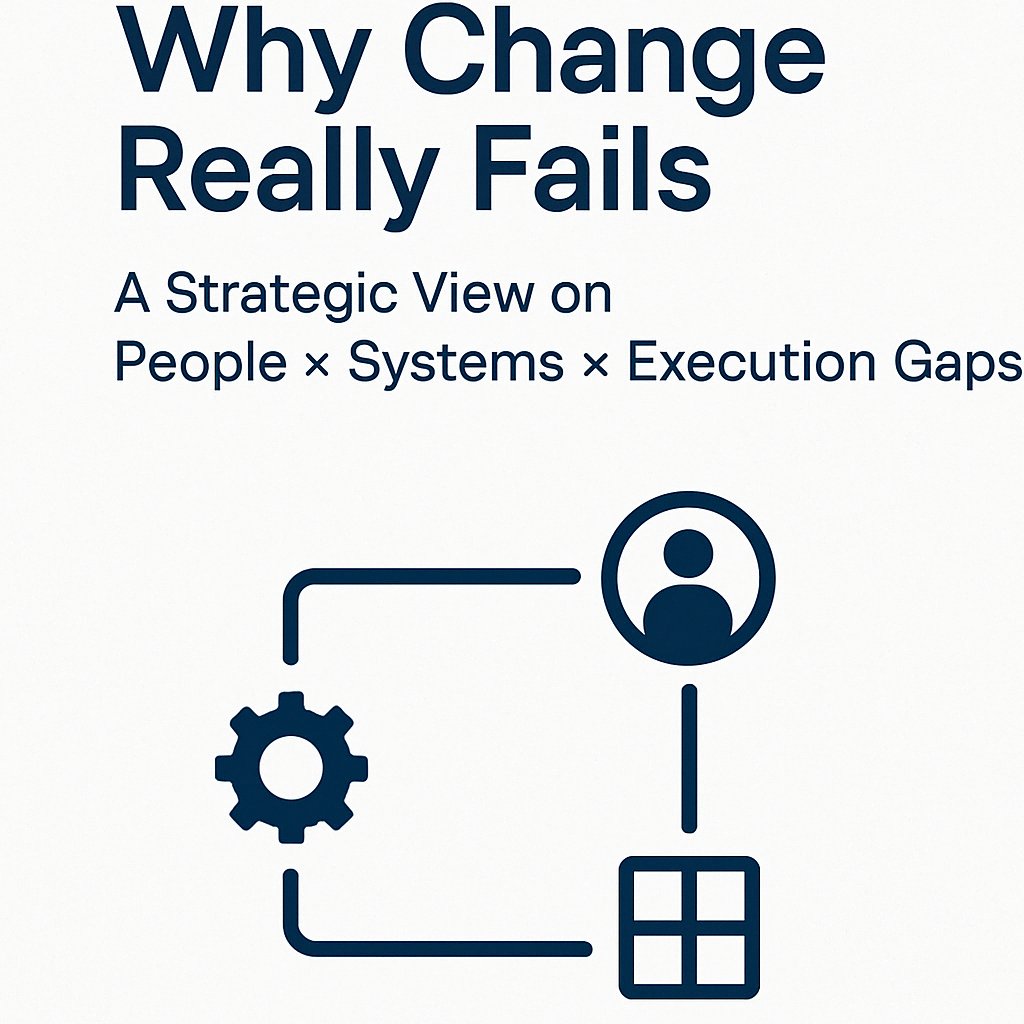 Why Change Really Fails: A Strategic View on People × Systems × Execution Gaps
Why Change Really Fails: A Strategic View on People × Systems × Execution Gaps
Why Change Really Fails: A Strategic View on People × Systems × Execution Gaps
Everyone blames people for resisting change
But that’s not the real reason change fails.
In my work across banking, marine offshore, and professional services, I’ve seen one consistent pattern: misalignment between people, systems, and strategy derails transformation.
This is the breakdown I see most often - and what I shared recently in a visual format on LinkedIn. Here’s the deeper view:
1. Change doesn’t fail because people resist.
It fails because leadership skips the hard work of alignment. If strategy, systems, and people aren’t moving together, change stalls, or worse, backfires.
2. People don’t fear change. They fear 'chaos'.
What they resist is being thrown into uncertainty without clarity, support, or context. Change feels threatening when it’s badly led.
3. Here’s what people really resist:
Confusion – No clarity on the purpose or path
Exclusion – Change is done to them, not with them
Poor Sponsorship – Leaders disappear after kickoff
4. Intent vs. Reality: The Leadership Gap
“We’ve communicated everything.” → “No one told us why.”
“The plan is clear.” → “Execution is chaos.”
“We gave support.” → “We’re doing this alone.”
Sound familiar? It’s not a comms issue. It’s a system gap.
5. Ask this before your next transformation:
Are we leading people through change… or just leaving them to survive it?
Change doesn’t land unless you guide people through it.
6. The takeaway?
In urgent, messy transformations, there’s one pattern that holds:
Change succeeds when People × Systems × Strategy move together.
This article is adapted from my original LinkedIn post
Follow me for grounded takes on what drives transformation, beyond buzzwords.
Tags: Leadership, HR, Change Management
 Chief Shared Services Officer | Transformation Strategist | Board-Level Advisor
Chief Shared Services Officer | Transformation Strategist | Board-Level Advisor
Location: Virtual, based in Abu Dhabi, UAE Fees: Fees based on engagement scope. Ava
Service Type: Service Offered
 Transforming Shared Services in the GCC - Touchless Digital Operations
Transforming Shared Services in the GCC - Touchless Digital Operations The Cost of Silence: How Good Teams Lose Their Voice
The Cost of Silence: How Good Teams Lose Their Voice The Reward Rift: What We Say We Value vs. What We Actually Reward
The Reward Rift: What We Say We Value vs. What We Actually Reward Who Gets the Room: Why Access Is the Most Misunderstood Signal in Organizations
Who Gets the Room: Why Access Is the Most Misunderstood Signal in Organizations Decision Theaters: When Data Becomes a Disguise
Decision Theaters: When Data Becomes a Disguise When Systems Speak Louder Than Leaders: The Hidden Economy of Organizational Signals
When Systems Speak Louder Than Leaders: The Hidden Economy of Organizational Signals